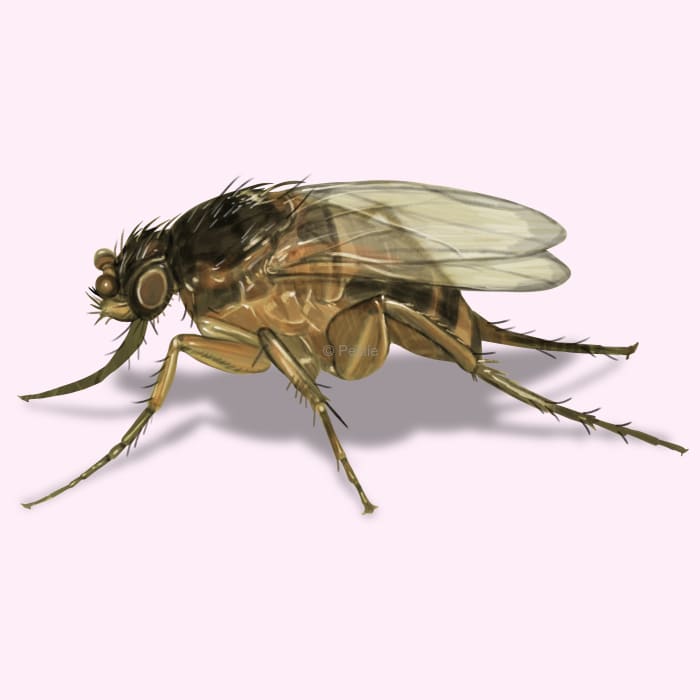How to identify and get rid of phorid flies

Phorid fly invasion? How to reclaim your home from these pesky pests
Have you ever noticed small flies in your home that seem completely crazy? These erratic flies are known as phorid flies or scuttle flies. They might look like dark-eyed fruit flies, but these little pests don't mind staying in your home long after the food is gone.
The presence of phorid flies in your home can mean that something is lurking in your drains or trash bins. That's because phorid flies love eating decaying organic matter, whether that's scum at the bottom of your drains or something dead nearby. Sometimes, a good culprit is a rotten potato or onion lost somewhere in your pantry.
Phorid flies can go by several names, including humpbacked or coffin flies. That last name comes from the fact that these flies are sometimes seen hanging around mausoleums or crypts. It's a disturbing image we don't need to dwell too long on!
However, for the average homeowner, with some savvy detective work and a few simple, non-chemical strategies, you can send these pests packing and reclaim your home as a no-fly zone.
How to identify phorid flies
Phorid flies can be identified by their small size and dark eyes. Additionally, its body is curved or humpbacked shaped. Often, its abdomen has brown bands that go across it, which are very much like fruit flies. Phorid flies prefer to erratically run over surfaces, like counters, screens, windows, or plants, instead of flying. You can often see them in groups doing this.
How big are phorid flies?
Phorid flies measure between 1/16 to 1/8 inch in length.
What other flies look like a phorid fly?
Because of their small size and presence in the kitchen, you might confuse phorid flies with fruit flies and fungus gnats. Fruit flies have red eyes, and fungus gnats will not run wildly on surfaces.
Where do phorid flies live?
They live throughout the United States, thriving both indoors and outdoors. Inside, they are found near garbage, drains, and overripe fruits. They can be found in compost piles or decaying organic matter outside.
How to get rid of phorid flies
Finding a bunch of phorid flies in your kitchen can be very annoying. No matter how much you clean, these flies tend to persist. However, you can do a few things to remove them from your home and keep them from getting established again.
First, you want to find where their larvae are growing. This can be anything from a clogged drain to dirty trash cans or even a dead animal nearby. Remove the source, which will help clear up the problem.
Additional helpful tips include:
- Clean sink and floor drains regularly
- Install or repair screen doors
- Keep dumpsters or trash cans far away from the home
- Inspect pantries frequently for rotten food
An insect barrier spray can also prevent phorid flies from entering the home. Pestie offers a DIY, pro-grade pest control plan that is easy to apply and tailored to your location. Get your customized plan here.
Treat phorid flies with Pestie
If you're still having trouble keeping phorid flies away, the best option is to use a pro-grade, effective pest control solution like Pestie.
Pestie is a do-it-yourself pest control solution that's specially designed to keep phorid flies and other pests away from your home.
With Pestie, you can rest easy knowing that your living space is protected and free of creepy crawlies. And the best part? It's designed for people, pets, and the planet, so you can say goodbye to harsh chemicals and hello to peace of mind!
- Save hundreds compared to traditional annual pest plans
- People, pet, and planet-friendly
- Pro-grade customized formulas
Quick facts
How dangerous are Phorid Flies?
Medium danger risk
While not directly harmful, phorid flies can be a nuisance. Because they are crawling around dead, decaying, and rotten things, they could easily spread bacteria wherever they go.
- Scientific name
Family - Phoridae
- Colors
Tan and brown
- Life span
2-4 weeks
- Diet
Moist organic matter, fungi, dead animals
Different types of phorid flies lay their eggs inside the heads of ants. Then the larva grows inside the head, eventually decapitating the ant's head, and pops it off!








